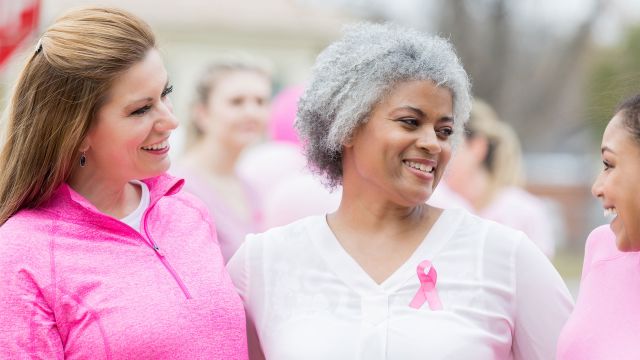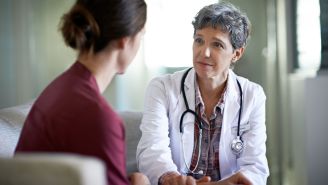Updated on March 28, 2024.
After lung cancer, breast cancer is the second leading cause of cancer death in women in the United States. An estimated 297,790 women were expected to be newly diagnosed with invasive breast cancer in 2023 and an estimated 43,700 to die from the disease, according to the American Cancer Society.
Experts say there is no sure way to prevent all breast cancers, as certain risk factors (such as advancing age and sex), are beyond a person's control. But there are certain steps people can take to reduce their risk of a breast cancer diagnosis. Tara M. Breslin, MD, a surgical oncologist with Trinity Health IHA Medical Group in Ypsilanti, Michigan, explains who is at risk as well as the factors that can and can’t be controlled.
Controllable breast cancer risk factors
A risk factor is something that increases the odds that you may develop a medical illness. There are several widely accepted steps that someone can take to reduce their risk factors for breast cancer. Among them are:
- Maintaining a healthy weight for you
- Staying physically active as you are able
- Refraining from drinking alcohol
- Quitting smoking
- Breastfeeding, if have a child and it is possible for you
- Limiting radiation exposure from medical imaging tests, if not medically necessary
Some of these same strategies also decrease the risk for other health concerns, says Dr. Breslin.
“Reducing overall body weight does lower the risk for certain types of breast cancer,” she says. “But, it also can reduce the risk for cardiovascular disease [heart and blood vessel disease], the number one killer of women in America.”
If detected early, breast cancer has a high rate of survival. Overall, roughly 99 percent of women live five years or more beyond diagnosis, if the disease is identified before it has spread outside the breast to other areas of the body.
Screening for people of average risk
Average-risk people are those whose estimated risk for developing breast cancer is about 13 percent, roughly a one-in-eight chance of being diagnosed with the disease in their lifetime. Screening mammography uses low dose x-rays to take images of the breast and may find signs of breast cancer before symptoms are noticed.
The American Cancer Society (ACS) advises that women can start screening between ages 40 and 45 if they choose. Beginning at 45, the ACS recommends mammograms every year. At 55, getting screened every one or two years is recommended as long as you are healthy and expect to live at least another decade.
Guidelines from the United States Preventive Services Task Force (USPSTF) differ somewhat from those from the ACS. In a draft recommendation statement published in May 2023, the USPSTF advises that women begin screening at age 40, and have mammograms every other year until age 74.
In her own practice, Breslin says she generally follows the guidelines of the American College of Radiology (ACR), which recommends most women begin screening at age 40.
Steps to take if you’re at a higher risk
Guidelines are more rigorous for people at high-risk for breast cancer. The ACR, for example, urges women at higher-than-average risk to begin screening as young as age 30, depending on their health profiles.
People at the highest risk for breast cancer include:
- People with family histories. Having a parent, sibling, or child diagnosed with breast cancer, especially before age 50, may double the lifetime risk. Having a close male blood relative with breast cancer also elevates the risk of breast cancer.
- Personal history of breast cancer. People who have had breast cancer are more likely to be diagnosed with a second occurrence.
- Genetic mutations or alterations. Less than 15 percent of women have known genetic changes, but carrying a mutation in genes called breast cancer 1 gene (BRCA1) or breast cancer 2 gene (BRCA2) can raise the risk for breast cancer between 45 to 85 percent. “It’s a wide estimate,” says Breslin. “But that’s because some mutations are associated with a higher risk than others.”
Surgery is the most obvious risk-reduction measure for people at high risk for breast cancer. But the decision to have a mastectomy (surgical removal of the breasts) depends on individual preference, Breslin says. A younger person in their 30s who is finished with childbearing or does not plan on having children, might opt for surgery, “knowing they have 30 or 40 years ahead of benefit,” she says. Someone in their 70s or 80s, on the other hand, might choose otherwise.
Risk-reduction strategies also can involve medications, such as tamoxifen and raloxifene which block the hormone estrogen that can fuel breast cancer growth in people who are premenopausal. HCPs may also prescribe aromatase inhibitors, another class of drugs that can slow estrogen production in someone who is in menopause.
If you are at high risk of developing breast cancer, your HCP can help you develop an individualized schedule for screenings, as well as work with you to determine which prevention techniques may be best for you.
After a breast cancer diagnosis
After being diagnosed and treated with breast cancer, risk-reduction talks need to take a different tone, according to Breslin. Some people may feel as if they did something to increase their risk, so Breslin tries to avoid any blame.
Losing weight can pose challenges, either because of the time of life when most breast cancers occur or from weight gain related to treatments. Still, Breslin encourages weight loss following treatment, as it’s associated with a lower rate of cancer recurrence.
Quitting tobacco may also improve response to cancer treatment and survival. If you smoke, ask your healthcare for help quitting, and whether your insurance or other organizations may help cover the costs.
“I guess my overall message is to keep enjoying life after a breast cancer diagnosis,” she says. “Use it as a ‘teachable’ moment to change things going forward to improve overall health.”






